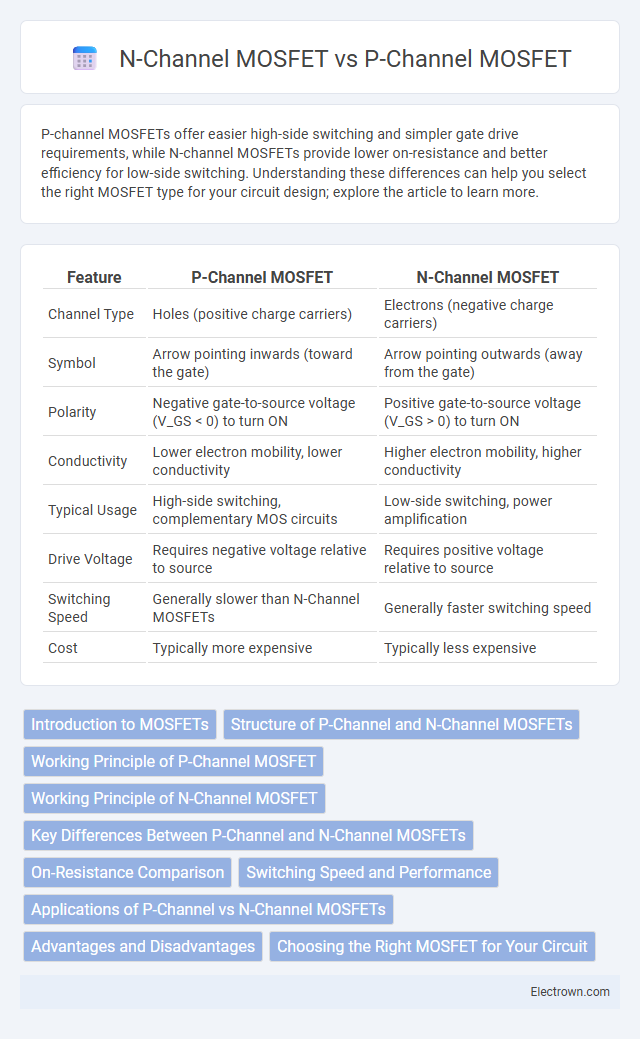P-channel MOSFETs offer easier high-side switching and simpler gate drive requirements, while N-channel MOSFETs provide lower on-resistance and better efficiency for low-side switching. Understanding these differences can help you select the right MOSFET type for your circuit design; explore the article to learn more.
Table of Comparison
| Feature | P-Channel MOSFET | N-Channel MOSFET |
|---|---|---|
| Channel Type | Holes (positive charge carriers) | Electrons (negative charge carriers) |
| Symbol | Arrow pointing inwards (toward the gate) | Arrow pointing outwards (away from the gate) |
| Polarity | Negative gate-to-source voltage (V_GS < 0) to turn ON | Positive gate-to-source voltage (V_GS > 0) to turn ON |
| Conductivity | Lower electron mobility, lower conductivity | Higher electron mobility, higher conductivity |
| Typical Usage | High-side switching, complementary MOS circuits | Low-side switching, power amplification |
| Drive Voltage | Requires negative voltage relative to source | Requires positive voltage relative to source |
| Switching Speed | Generally slower than N-Channel MOSFETs | Generally faster switching speed |
| Cost | Typically more expensive | Typically less expensive |
Introduction to MOSFETs
MOSFETs are semiconductor devices used to switch or amplify electronic signals, with p-channel and n-channel types differing primarily in charge carriers and conduction behavior. An n-channel MOSFET conducts when a positive voltage is applied to the gate relative to the source, allowing electrons to flow, while a p-channel MOSFET conducts with a negative gate voltage, using holes as charge carriers. Understanding these differences helps you select the appropriate MOSFET type for efficient circuit design and performance.
Structure of P-Channel and N-Channel MOSFETs
P-channel MOSFETs consist of a p-type substrate with n-type source and drain regions, allowing hole conduction when a negative gate voltage is applied. N-channel MOSFETs feature an n-type substrate with p-type source and drain regions, enabling electron conduction under a positive gate voltage. The structural differences dictate their electrical characteristics, with p-channel devices generally exhibiting higher on-resistances and slower switching speeds compared to n-channel counterparts.
Working Principle of P-Channel MOSFET
The working principle of a P-channel MOSFET involves controlling the flow of holes as majority carriers between the source and drain terminals through an induced p-type channel when a negative voltage is applied to the gate relative to the source. Unlike an N-channel MOSFET that uses electrons as carriers, the P-channel MOSFET turns on by creating a conductive channel in the p-type substrate allowing current to flow from source to drain. Understanding this mechanism helps you select the appropriate MOSFET type for applications requiring high-side switching or complementary circuit designs.
Working Principle of N-Channel MOSFET
N-Channel MOSFETs operate by creating a conductive channel between the source and drain terminals when a positive voltage is applied to the gate relative to the source, allowing electrons to flow. The electron mobility in N-Channel MOSFETs is higher than hole mobility in P-Channel MOSFETs, resulting in faster switching speeds and lower on-resistance. Understanding the working principle of N-Channel MOSFETs can help you optimize circuit designs requiring efficient switching performance.
Key Differences Between P-Channel and N-Channel MOSFETs
P-channel MOSFETs conduct when the gate voltage is lower than the source, while N-channel MOSFETs conduct when the gate voltage is higher than the source, making N-channel devices generally faster and more efficient due to higher electron mobility. N-channel MOSFETs typically have lower on-resistance (Rds(on)) compared to P-channel MOSFETs, resulting in improved performance in switching applications. The body diodes in P-channel MOSFETs are oriented in the opposite direction to those in N-channel MOSFETs, influencing their use in different circuit configurations and load switching.
On-Resistance Comparison
P-channel MOSFETs typically exhibit higher on-resistance (R_DS(on)) compared to N-channel MOSFETs due to lower electron mobility in the p-type channel versus the higher electron mobility in n-type channels. This difference results in N-channel MOSFETs being more efficient for switching applications, as their lower R_DS(on) reduces power loss and heat generation. Designers often prefer N-channel devices in low-voltage, high-current circuits for optimal performance and energy efficiency.
Switching Speed and Performance
N-channel MOSFETs generally offer faster switching speeds and better performance due to their higher electron mobility compared to holes in p-channel MOSFETs. This results in lower on-resistance and more efficient current conduction, making N-channel MOSFETs more suitable for high-speed and high-performance applications. When optimizing your circuit for switching speed and efficiency, choosing an N-channel MOSFET can significantly enhance performance.
Applications of P-Channel vs N-Channel MOSFETs
N-channel MOSFETs are commonly used in low-side switch applications due to their lower on-resistance and higher electron mobility, making them ideal for power management and amplification circuits. P-channel MOSFETs are preferred for high-side switching in battery-powered devices and load switches because they simplify gate drive requirements by allowing direct control from the positive voltage rail. Combining both types in complementary configurations enhances efficiency and switching performance in DC-DC converters and H-bridge motor controllers.
Advantages and Disadvantages
P-channel MOSFETs offer simpler high-side switching in positive voltage applications but generally exhibit higher on-resistance and slower switching speeds compared to N-channel MOSFETs. N-channel MOSFETs provide lower conduction losses and higher efficiency due to better electron mobility but require more complex gate drive circuitry for high-side configurations. Choosing between P-channel and N-channel MOSFETs depends on the trade-off between ease of control and electrical performance in the specific circuit design.
Choosing the Right MOSFET for Your Circuit
Choosing the right MOSFET for your circuit depends on factors such as switching speed, voltage handling, and on-resistance. N-channel MOSFETs typically offer lower on-resistance and faster switching, making them ideal for high-efficiency power applications. P-channel MOSFETs simplify high-side switching but generally have slower switching speeds and higher on-resistance, influencing their suitability for low-side or less efficiency-critical circuits.
p-channel mosfet vs n-channel mosfet Infographic

 electrown.com
electrown.com